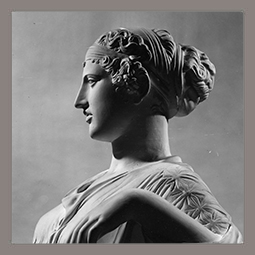edited by M. Papini
The visual arts in the classical world (particularly between the 6th and the 4th century BC) should be considered as a form of high craftsmanship: as Ranuccio Bianchi Bandinelli famously stated, the artistic intensity of the design on an Attic vase can equal a metope of the Parthenon. Nonetheless, works of the first order were naturally recognized as such, even in Antiquity. In the 4th century BC, Isocrates, at the beginning of his speech entitled Antidosis, complained against some persons (the ‘sophists’) who attempted to belittle his activity. They styled the orator as a mere scribbler, suitable only for writing speeches for the courts, while in his writings he addressed complex philosophical and political themes. According to Isocrates’ reply, it was as if his opponents were referring to Phidias as a doll maker or to Zeuxis and Parrhasius as painters of votive tablets, for the sole reason that simple craftsmen and great artists both relied on the same techniques. The volume includes contributions from an international workshop held at Sapienza, University of Rome (15-16 June 2023); the workshop was organized by Massimiliano Papini, joined in the scientific committee by Andrea Cucchiarelli and Giorgio Piras. The collected papers aim to address various problems related to the activity of the most illustrious Greek artisans, such as painters, sculptors, and gem engravers. Individual cases are discussed from different perspectives and with special attention to the presence of Greek works of art in Rome, throughout the centuries. During the Republic, even the most eminent men in Rome could be speechless while contemplating a painting by Aetion or a statue by Polykleitos (so Cicero in his work Paradoxa stoicorum). The title of these proceedings is partly inspired by that of a late novel by Thomas Bernhard (Old Master: A Comedy, 1985). The main character of the novel, an elderly musicologist named Reger, sits every two days in the Bordone Room of the Kunsthistorisches Museum in Vienna to observe a painting by Tintoretto, and finally he claims that «art historians twaddle so long about art until they have killed it with their twaddle». Conversely, he enjoys listening to the custodian as he explains the subject of a painting because «he is not a twaddler, just a modest enlightener and reporter who leaves the work of art open to the beholder, without closing it with his chatter». That may be true, sometimes. After all, people are able to instinctively recognize the merits and defects of certain works of art, despite their limited education (once again, this is a statement from Cicero: De oratore, Book 3). Accordingly, there are paintings and statues that delight the eyes even of those that are not connoisseurs. And there are some Greek ‘Old Masters’ who cannot be ignored. To be considered ‘human’, one must know the name of Praxiteles for his mastery of sculpture, as M. Terentius Varro states in the opening sentence of his treatise Antiquitates rerum humanarum. Knowledge of Greek artists is therefore an essential part of good culture and education – in a word, humanitas.
Sommario
M. Papini, Potresti supporre che siano di Fidia, Lisippo o Prassitele”: intorno agli antichi maestri, pp. 3-16
I. Starnino, La τέχνη al servizio del territorio: il racconto “storico” di Dedalo in Sicilia, pp. 17-26
G. Marginesu, Quantificare il capolavoro. Ancora sul problema epigrafico dei così detti rendiconti della Promachos, pp. 27-32
R. Sassu, Riconsiderazioni sulla figura di Alcamene: opere e cronologia, pp. 33-48
G. Rocco, Centauri a simposio: alle origini del soggetto, tra pittura e ceramografia, pp. 49-64
E. La Rocca, L’iscrizione di Skopas minore dal foro Boario e le sculture attribuite da Plinio a Skopas, pp. 65-92
L. Rebaudo, Un fantasma ellenistico: Doidalsas di Bitinia, pp. 93-110
A. Mortellaro, “La incoronatione di Rosana […] amata grandemente da Alessandro”: un quadro di Aezione e la sua fortuna, pp. 111-124
L. Lulli, Artigiani della poesia: la rappresentazione del poeta nella critica letteraria antica, pp. 125-135
M. Cadario, Un diverso modo di firmare o un marchio di qualità? La techne di Teodoro di Samo nelle Tabulae Iliacae, pp. 137-149
M. Russo, Valerio Massimo e l’arte greca, pp. 151-160
A. Rolle, Antichi maestri nelle scuole di retorica in Grecia e a Roma: il caso di Fidia, pp. 161-168
M. Citroni, I maestri delle arti figurative nella teoria retorica di Cicerone e di Quintiliano, pp. 169-179
A. Pittà, Varrone e/in Plinio il Vecchio: capolavori greci nel paesaggio letterario di Roma, pp. 181-191
M. Papini, Plinio il Vecchio e le fonti della pittura greca, pp. 193-210
C. Ballestrazzi, Alibi ars, alibi materia. I maestri delle gemme in Grecia e a Roma, pp. 211-222
F. Econimo, Mentoris haec manus est an, Polyclite, tua? Cataloghi di artisti greci nella poesia encomiastica di Stazio e Marziale, pp. 223-233
R. Bucolo, M. Curcio, Alla ricerca dell’originale perduto: ricostruzioni in gesso dal Museo dell’Arte Classica Sapienza come modelli di Meisterforschung, pp. 235-245

